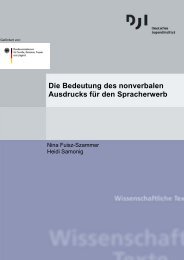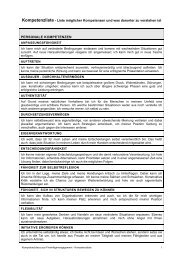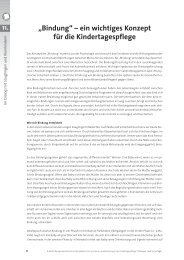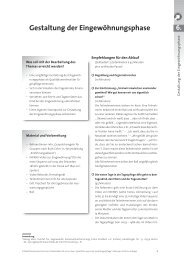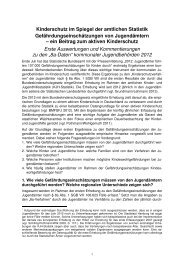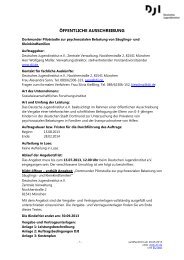Assessing the effects of informal learning on occupational compe ...
Assessing the effects of informal learning on occupational compe ...
Assessing the effects of informal learning on occupational compe ...
Create successful ePaper yourself
Turn your PDF publications into a flip-book with our unique Google optimized e-Paper software.
Serious developers <str<strong>on</strong>g>of</str<strong>on</strong>g> ACs (e.g., <str<strong>on</strong>g>the</str<strong>on</strong>g> IMBSE) have <str<strong>on</strong>g>the</str<strong>on</strong>g>ir procedures tested<br />
for validity and reliability using <str<strong>on</strong>g>the</str<strong>on</strong>g> customary and recognized statistical test<br />
procedures. However, <str<strong>on</strong>g>the</str<strong>on</strong>g> results are <strong>on</strong>ly published in excepti<strong>on</strong>al cases<br />
(e.g., Druckrey 2001) and are not always c<strong>on</strong>vincing (Arbeitsgemeinschaft<br />
QUEM 1999, pp. 58–9).<br />
Procedures for establishing <strong>compe</strong>tence such as <str<strong>on</strong>g>the</str<strong>on</strong>g> AC are extremely<br />
expensive in terms <str<strong>on</strong>g>of</str<strong>on</strong>g> time, costs, and pers<strong>on</strong>nel, since <str<strong>on</strong>g>the</str<strong>on</strong>g>y usually take<br />
several days and numerous observers have to be used (who also have to<br />
receive time-c<strong>on</strong>suming training beforehand). In acti<strong>on</strong>-oriented procedures<br />
such as <str<strong>on</strong>g>the</str<strong>on</strong>g> AC, <strong>on</strong>e observer is needed for a maximum <str<strong>on</strong>g>of</str<strong>on</strong>g> two participants.<br />
Depending <strong>on</strong> <str<strong>on</strong>g>the</str<strong>on</strong>g> way <str<strong>on</strong>g>the</str<strong>on</strong>g> procedure is designed, a period <str<strong>on</strong>g>of</str<strong>on</strong>g> 5–10 days is<br />
required (Hiba 2003, p. 7). The ‘full versi<strong>on</strong>’ <str<strong>on</strong>g>of</str<strong>on</strong>g> <str<strong>on</strong>g>the</str<strong>on</strong>g> DIAgnosis and TRAI-<br />
Ning unit, for example, is designed for eight young people and takes a total<br />
<str<strong>on</strong>g>of</str<strong>on</strong>g> 10 working days. It includes seven different procedures: social training<br />
with 17 exercises, a biographical interview, a creativity training unit, 12 experiential<br />
teaching exercises, an Assessment Centre with nine tasks, a <str<strong>on</strong>g>learning</str<strong>on</strong>g><br />
training unit, and a future workshop. Very few potential users (e.g., sec<strong>on</strong>dary<br />
modern schools and remedial schools) are ei<str<strong>on</strong>g>the</str<strong>on</strong>g>r willing or able to afford<br />
<str<strong>on</strong>g>the</str<strong>on</strong>g> time and energy for this. Only a trimmed-down ‘practicable’ versi<strong>on</strong> is<br />
<str<strong>on</strong>g>the</str<strong>on</strong>g>refore likely to be used. Whe<str<strong>on</strong>g>the</str<strong>on</strong>g>r this procedure is <str<strong>on</strong>g>the</str<strong>on</strong>g>n capable <str<strong>on</strong>g>of</str<strong>on</strong>g> measuring<br />
what it is intended to, however, is an open questi<strong>on</strong>.<br />
Apart from <str<strong>on</strong>g>the</str<strong>on</strong>g>se deficiencies and problems at <str<strong>on</strong>g>the</str<strong>on</strong>g> level <str<strong>on</strong>g>of</str<strong>on</strong>g> implementati<strong>on</strong>,<br />
<str<strong>on</strong>g>the</str<strong>on</strong>g> most important thing in this c<strong>on</strong>text is that although <str<strong>on</strong>g>the</str<strong>on</strong>g> current procedures<br />
for establishing <strong>compe</strong>tence for young people with special support<br />
needs shift <str<strong>on</strong>g>the</str<strong>on</strong>g> focus towards social and communicative, pers<strong>on</strong>al and<br />
methodological <strong>compe</strong>tences and away from specialist and instrumental<br />
<strong>compe</strong>tences, <str<strong>on</strong>g>the</str<strong>on</strong>g>y never<str<strong>on</strong>g>the</str<strong>on</strong>g>less neglect abilities and <strong>compe</strong>tences that young<br />
people have assimilated during <str<strong>on</strong>g>the</str<strong>on</strong>g> processes <str<strong>on</strong>g>of</str<strong>on</strong>g> <str<strong>on</strong>g>informal</str<strong>on</strong>g> <str<strong>on</strong>g>learning</str<strong>on</strong>g> outside <str<strong>on</strong>g>of</str<strong>on</strong>g><br />
traditi<strong>on</strong>al educati<strong>on</strong>al instituti<strong>on</strong>s (family, peers, clubs, dealing with <str<strong>on</strong>g>the</str<strong>on</strong>g><br />
media, computer and <str<strong>on</strong>g>the</str<strong>on</strong>g> Internet, sport, manual and creative activities, etc.).<br />
In what follows below, we will <str<strong>on</strong>g>the</str<strong>on</strong>g>refore take a closer look at <str<strong>on</strong>g>informal</str<strong>on</strong>g> <str<strong>on</strong>g>learning</str<strong>on</strong>g><br />
and <str<strong>on</strong>g>informal</str<strong>on</strong>g>ly acquired <strong>compe</strong>tences.<br />
13 <str<strong>on</strong>g>Assessing</str<strong>on</strong>g> <str<strong>on</strong>g>the</str<strong>on</strong>g> <str<strong>on</strong>g>effects</str<strong>on</strong>g> <str<strong>on</strong>g>of</str<strong>on</strong>g> <str<strong>on</strong>g>informal</str<strong>on</strong>g> <str<strong>on</strong>g>learning</str<strong>on</strong>g> <strong>on</strong> occupati<strong>on</strong>al <strong>compe</strong>tences <str<strong>on</strong>g>of</str<strong>on</strong>g> disadvantaged young pers<strong>on</strong>s




